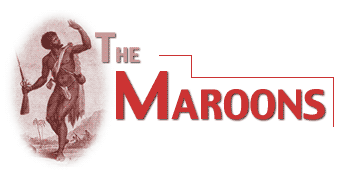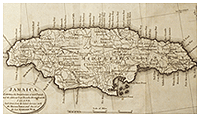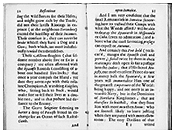 | 
 |
We can trace the tale of the courageous run away slaves, or Maroons of Jamaica, back to 1655, when the British captured that island. This crucial time in Jamaican history marked the end of Spanish power and the rise of an independent force in Jamaica, the Maroons. When the British conquered Jamaica, many of the Spanish inhabitants fled to neighboring Cuba, leaving behind their slaves. However, because the British soldiers were so few in number, they were only able to occupy the south side of the island. As a result , many Spaniards were able to remain in Jamaica and inhabit the north side of the island in a town then known as Sevilla Nueva.
 The Spaniards in Jamaica kept up communication with their former neighbors who were now living on the south side of Cuba. Less than 24 hours away on sail, the Spaniards in Cuba would eventually be called upon to help those in Jamaica try to regain control of the island. In 1655, Don Arnoldo de Sasi, the old governor, five hundred of the former inhabitants, and one thousand troops from Old Spain, landed at Rio Nuevo east of Seville where they built a fort. But, the surprise attack was quickly suppressed when Colonel Doyley, the English governor, arrived with five hundred men from the south side of Jamaica and forced the Spanish to run back to their safe haven in Cuba. The Spaniards in Jamaica kept up communication with their former neighbors who were now living on the south side of Cuba. Less than 24 hours away on sail, the Spaniards in Cuba would eventually be called upon to help those in Jamaica try to regain control of the island. In 1655, Don Arnoldo de Sasi, the old governor, five hundred of the former inhabitants, and one thousand troops from Old Spain, landed at Rio Nuevo east of Seville where they built a fort. But, the surprise attack was quickly suppressed when Colonel Doyley, the English governor, arrived with five hundred men from the south side of Jamaica and forced the Spanish to run back to their safe haven in Cuba.
With the departure of their Spanish masters, about 1500 slaves decided to seek refuge on the north and east sides of the mountains rather than to submit to the conquerors or follow the fortunes of their former owners. As Dallas’ History of the Maroons Vol I mentions, it is believed that "for some time they were instigated by their former masters to commit hostilities against the new possessors of the country." Although this idea seemed unlikely, the possibilities of communicating with their former slaves could have been accomplished since Cuba was so to Jamaica, and because the Spaniards were very familiar in navigating the leeward islands.
 Located in different parts of the island, most of the Spanish slaves from the south side of Jamaica sought refuge in the mountains of Clarendon where they were led by a chief named Juan de Bolas. Under his leadership, many of these Clarendon Spanish slaves attacked the British inhabitants of Jamaica, as well as the other fugitive slaves of the island. However, once they were defeated and their leader slain, the Clarendon slaves began diminishing in number, never to return to their safe haven in the mountains. Located in different parts of the island, most of the Spanish slaves from the south side of Jamaica sought refuge in the mountains of Clarendon where they were led by a chief named Juan de Bolas. Under his leadership, many of these Clarendon Spanish slaves attacked the British inhabitants of Jamaica, as well as the other fugitive slaves of the island. However, once they were defeated and their leader slain, the Clarendon slaves began diminishing in number, never to return to their safe haven in the mountains.
After the quiet retreat of the Clarendon fugitives, the fugitive slaves that remained were given the name Maroons, which was taken from the Spanish word "cimarrones" meaning unruly, fugitive, and wild. The Spaniards used this term to refer to wild cattle that had escaped. Living mainly in the northern and eastern parts of the island, this surviving group of fugitive slaves waged war against Jamaica’s English settlers.
However, another group of fugitives would soon arise. In 1690 a group of slaves from the Clarendon parish rebelled against their masters and sought refuge in the interior parts of the country. Through the recruitment of other plantation slaves, this new group of Clarendon fugitives increased in number and acquired the necessary provisions from the plantations of their newest recruits. In time, these rebels, not yet associated with the Maroons living in the east, would plunder plantations, destroy cattle, and carry off slaves by force in order to survive, simultaneously causing planters to constantly live in a state of fear. As a result, the planters made many complaints to the British legislation and parties of armed forces were soon organized to kill the Clarendon rebels. The Clarendon rebels, who always traveled in small gangs without a particular leader, decided to organize themselves and appoint a chief who would protect them from the wrath of the Jamaican colonists. They picked Cudjoe, "a bold, skillful, and enterprising man," he in turn appointed his brothers Accompong and Johnny to lead under him, and Cuffee and Quao as Captains.
 With new leadership and an increase in size, due to the Coromantee slaves who had joined them , the Clarendon rebels were gaining strength in numbers and through their leadership. Moreover, Cudjoe's war against the white inhabitants of Jamaica had brought him great fame amongst the white planters and the fugitive slaves alike. As a result, a group known as the Cottawoods, who had separated from the other Maroons prior to 1730, marched through the mountainous, uninhabited areas of the country to join Cudjoe and the Clarendon rebels. Hundreds of Cottawood members joined Cudjoe until they were all united again under his leadership. Another group, known as the Madagascars, also joined Cudjoe and the Clarendon rebels. According to Dallas, these negroes where "distinct in every respect; their figure, character, language, and country, being different from those of the other blacks." The Madagascars, who were small in number, claimed to have run away from the settlements around an area known as Lacovia in the parish of St. Elizabeth after the planters had purchased them. Although these three groups merged, each attempted to preserve their group names and language: Cottawood referring to the former Maroons; Kencufees referring to the original fugitives under Cudjoe. However, throughout the years, the Madagascars eventually lost their native language and learned the Coromantee language, which was in use by everyone else among the Maroons. Finally, in 1730, the Jamaican planters parties of armed forces were sent out against Cudjoe and his people. Those under his leadership were given the name Maroon, which was a term originally given to the original Spanish fugitives. With new leadership and an increase in size, due to the Coromantee slaves who had joined them , the Clarendon rebels were gaining strength in numbers and through their leadership. Moreover, Cudjoe's war against the white inhabitants of Jamaica had brought him great fame amongst the white planters and the fugitive slaves alike. As a result, a group known as the Cottawoods, who had separated from the other Maroons prior to 1730, marched through the mountainous, uninhabited areas of the country to join Cudjoe and the Clarendon rebels. Hundreds of Cottawood members joined Cudjoe until they were all united again under his leadership. Another group, known as the Madagascars, also joined Cudjoe and the Clarendon rebels. According to Dallas, these negroes where "distinct in every respect; their figure, character, language, and country, being different from those of the other blacks." The Madagascars, who were small in number, claimed to have run away from the settlements around an area known as Lacovia in the parish of St. Elizabeth after the planters had purchased them. Although these three groups merged, each attempted to preserve their group names and language: Cottawood referring to the former Maroons; Kencufees referring to the original fugitives under Cudjoe. However, throughout the years, the Madagascars eventually lost their native language and learned the Coromantee language, which was in use by everyone else among the Maroons. Finally, in 1730, the Jamaican planters parties of armed forces were sent out against Cudjoe and his people. Those under his leadership were given the name Maroon, which was a term originally given to the original Spanish fugitives.
The Maroons retreated to the mountains throughout the mid-seventeenth century, unaware of the impact they would make on British and Jamaican history. With a vast knowledge of the uninhabited Jamaican mountain side, the Maroons were able to wage war against British planters and eventually contract a peace agreement with the British. Through the courage of fugitive slaves and the leadership of Cudjoe and his colleagues, the Maroons became a people whose history exemplified the driving force of freedom.
|
| R. C. Dallas, Esq., The History of the Maroons, Vol I, (London, 1803). |

 |





